TOYOTA PRIUS C 2020 Owners Manual
Manufacturer: TOYOTA, Model Year: 2020, Model line: PRIUS C, Model: TOYOTA PRIUS C 2020Pages: 600, PDF Size: 12.02 MB
Page 221 of 600
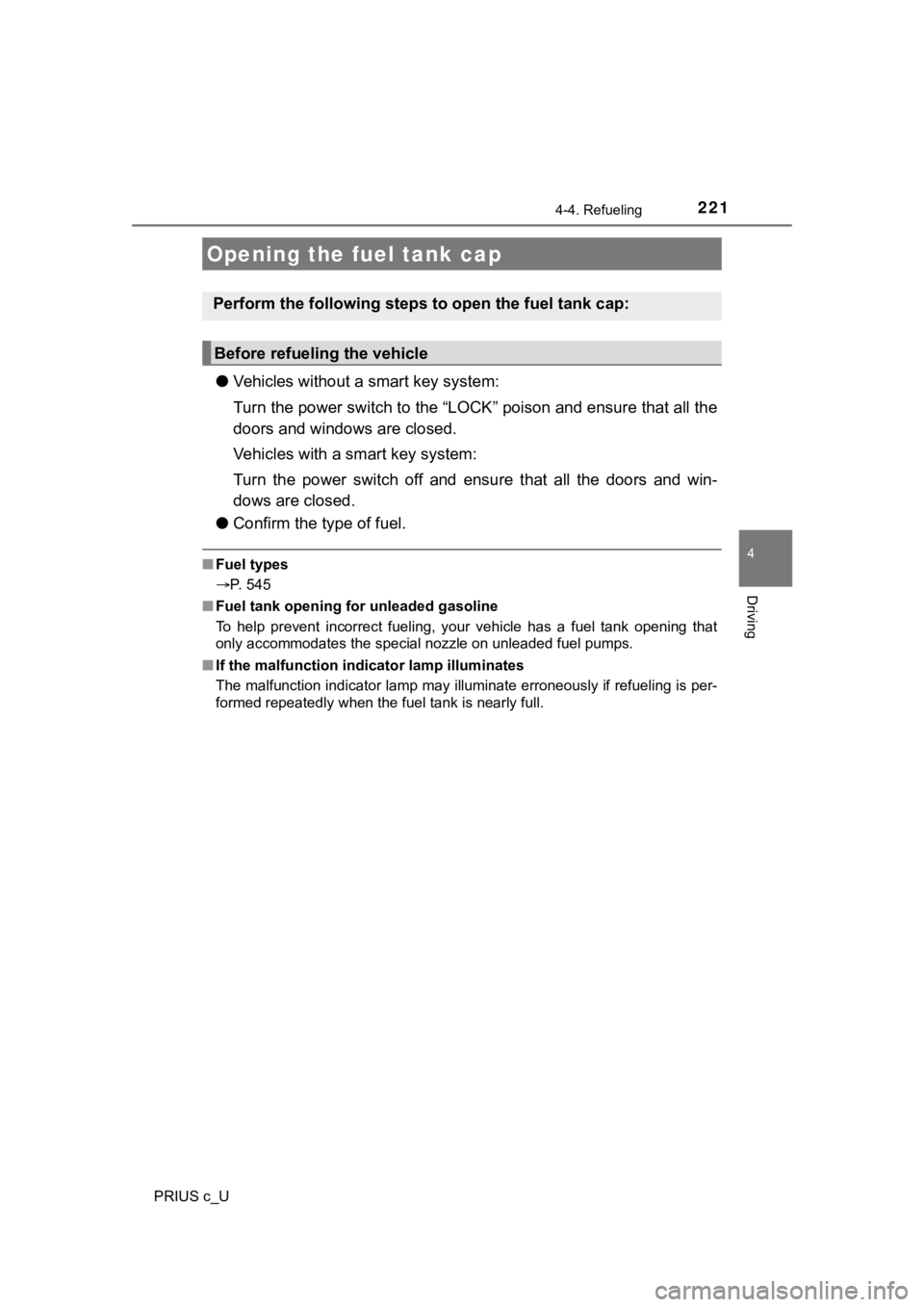
221
4
Driving
PRIUS c_U
4-4. Refueling
●Vehicles without a smart key system:
Turn the power switch to the “LOCK” poison and ensure that all the
doors and windows are closed.
Vehicles with a smart key system:
Turn the power switch off and ensure that all the doors and win -
dows are closed.
● Confirm the type of fuel.
■Fuel types
P. 545
■ Fuel tank opening for unleaded gasoline
To help prevent incorrect fueling, your vehicle has a fuel tank opening that
only accommodates the special nozzle on unleaded fuel pumps.
■ If the malfunction indicator lamp illuminates
The malfunction indicator lamp may illuminate erroneously if re fueling is per-
formed repeatedly when the fuel tank is nearly full.
Opening the fuel tank cap
Perform the following steps to open the fuel tank cap:
Before refueling the vehicle
Page 222 of 600
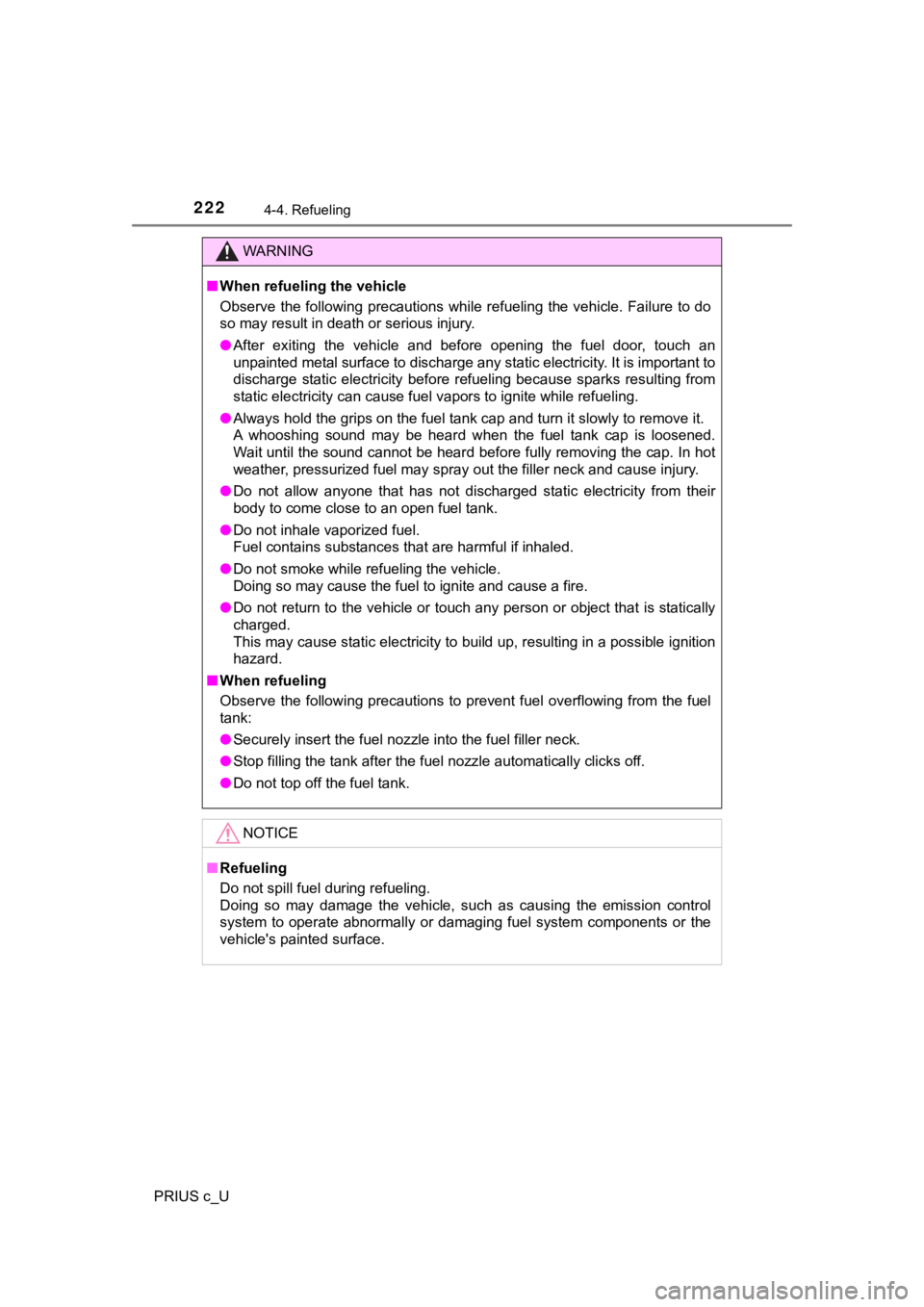
2224-4. Refueling
PRIUS c_U
WARNING
■When refueling the vehicle
Observe the following precautions while refueling the vehicle. Failure to do
so may result in death or serious injury.
● After exiting the vehicle and before opening the fuel door, tou ch an
unpainted metal surface to discharge any static electricity. It is important to
discharge static electricity before refueling because sparks re sulting from
static electricity can cause fuel vapors to ignite while refuel ing.
● Always hold the grips on the fuel tank cap and turn it slowly t o remove it.
A whooshing sound may be heard when the fuel tank cap is loosen ed.
Wait until the sound cannot be heard before fully removing the cap. In hot
weather, pressurized fuel may spray out the filler neck and cause injury.
● Do not allow anyone that has not discharged static electricity from their
body to come close to an open fuel tank.
● Do not inhale vaporized fuel.
Fuel contains substances that are harmful if inhaled.
● Do not smoke while refueling the vehicle.
Doing so may cause the fuel to ignite and cause a fire.
● Do not return to the vehicle or touch any person or object that is statically
charged.
This may cause static electricity to build up, resulting in a p ossible ignition
hazard.
■ When refueling
Observe the following precautions to prevent fuel overflowing f rom the fuel
tank:
● Securely insert the fuel nozzle into the fuel filler neck.
● Stop filling the tank after the fuel nozzle automatically click s off.
● Do not top off the fuel tank.
NOTICE
■Refueling
Do not spill fuel during refueling.
Doing so may damage the vehicle, such as causing the emission c ontrol
system to operate abnormally or damaging fuel system components or the
vehicle's painted surface.
Page 223 of 600
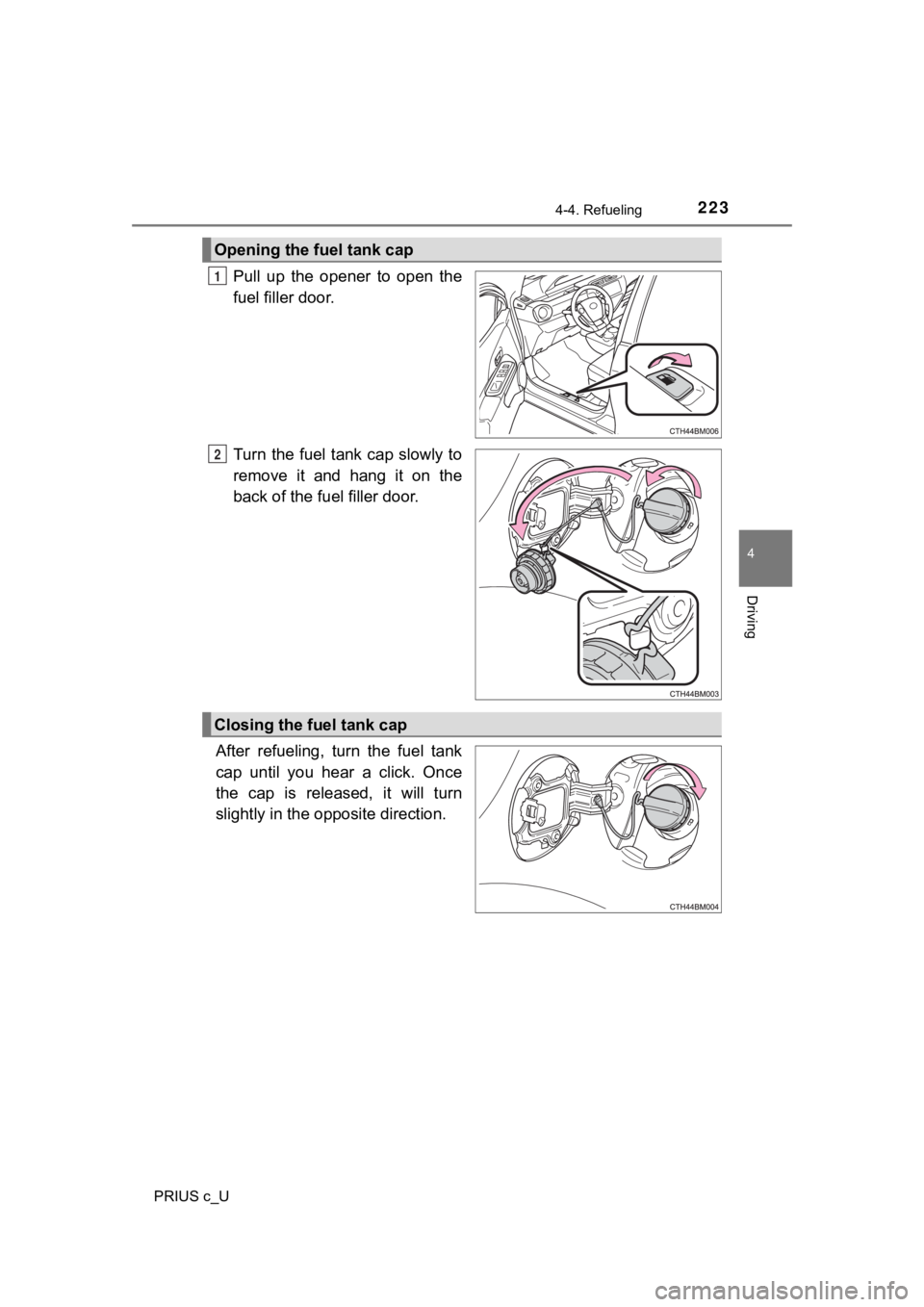
2234-4. Refueling
4
Driving
PRIUS c_U
Pull up the opener to open the
fuel filler door.
Turn the fuel tank cap slowly to
remove it and hang it on the
back of the fuel filler door.
After refueling, turn the fuel tank
cap until you hear a click. Once
the cap is released, it will turn
slightly in the opposite direction.
Opening the fuel tank cap
1
2
Closing the fuel tank cap
Page 224 of 600

2244-4. Refueling
PRIUS c_U
WARNING
■When replacing the fuel tank cap
Do not use anything but a genuine Toyota fuel tank cap designed for your
vehicle. Doing so may cause a fire or other incident which may result in
death or serious injury.
Page 225 of 600
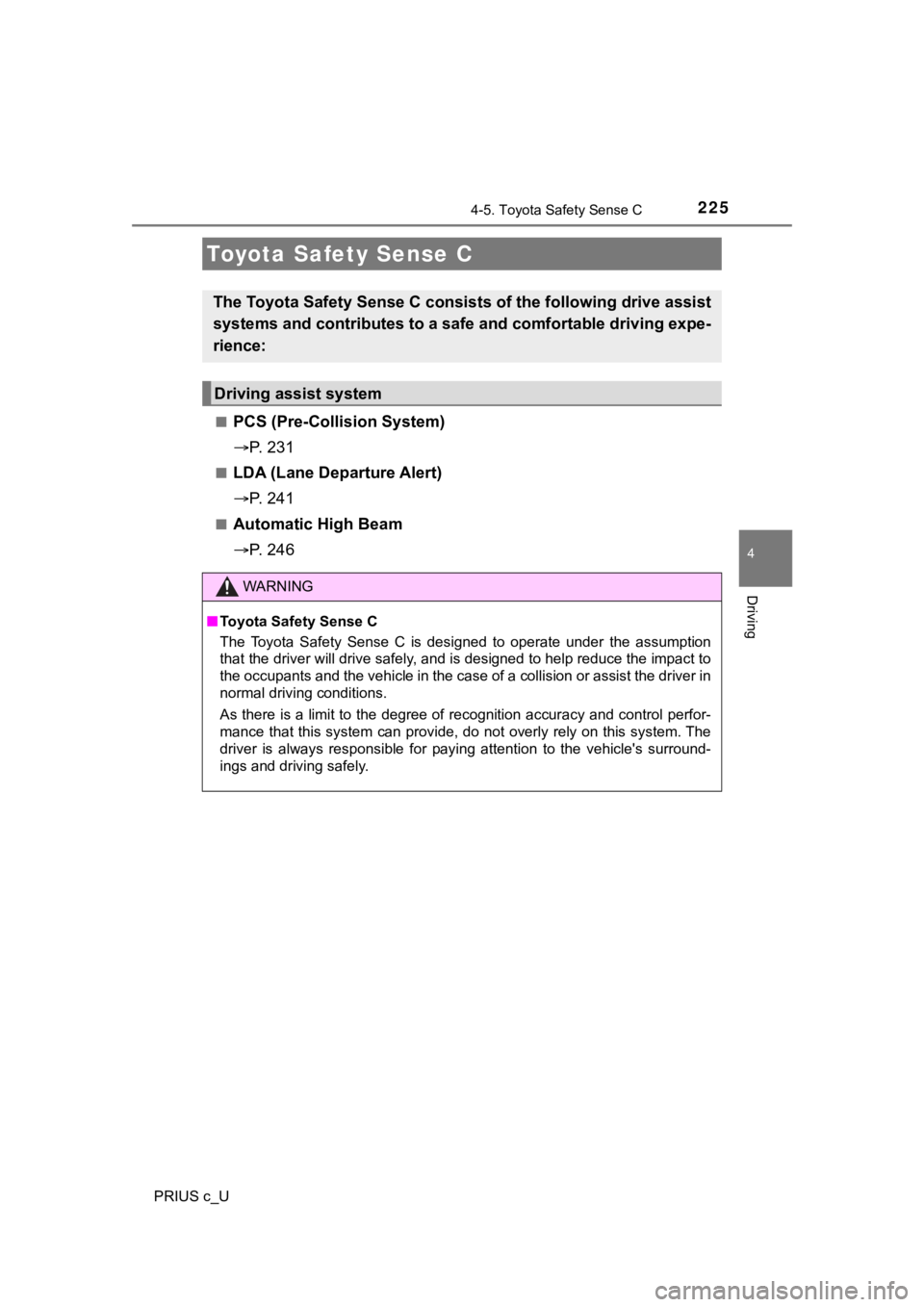
225
4
Driving
PRIUS c_U
4-5. Toyota Safety Sense C
■PCS (Pre-Collision System)
P. 2 3 1
■LDA (Lane Departure Alert)
P. 2 4 1
■Automatic High Beam
P. 2 4 6
Toyota Safety Sense C
The Toyota Safety Sense C consis ts of the following drive assist
systems and contributes to a safe and comfortable driving expe-
rience:
Driving assist system
WARNING
■ Toyota Safety Sense C
The Toyota Safety Sense C is designed to operate under the assu mption
that the driver will drive safely, and is designed to help redu ce the impact to
the occupants and the vehicle in the case of a collision or ass ist the driver in
normal driving conditions.
As there is a limit to the degree of recognition accuracy and control perfor-
mance that this system can provide, do not overly rely on this system. The
driver is always responsible for paying attention to the vehicl e's surround-
ings and driving safely.
Page 226 of 600
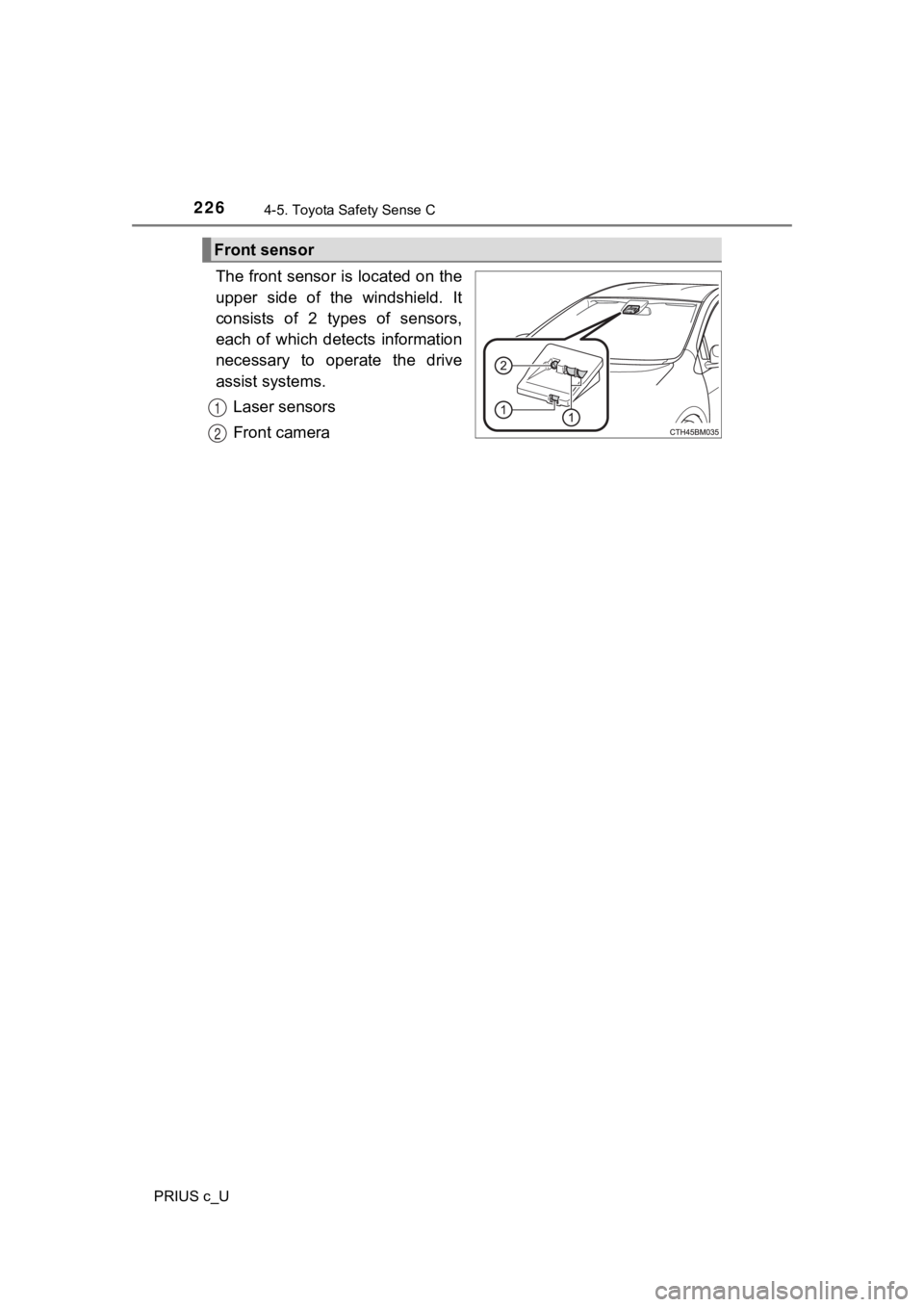
2264-5. Toyota Safety Sense C
PRIUS c_U
The front sensor is located on the
upper side of the windshield. It
consists of 2 types of sensors,
each of which detects information
necessary to operate the drive
assist systems.Laser sensors
Front camera
Front sensor
1
2
Page 227 of 600
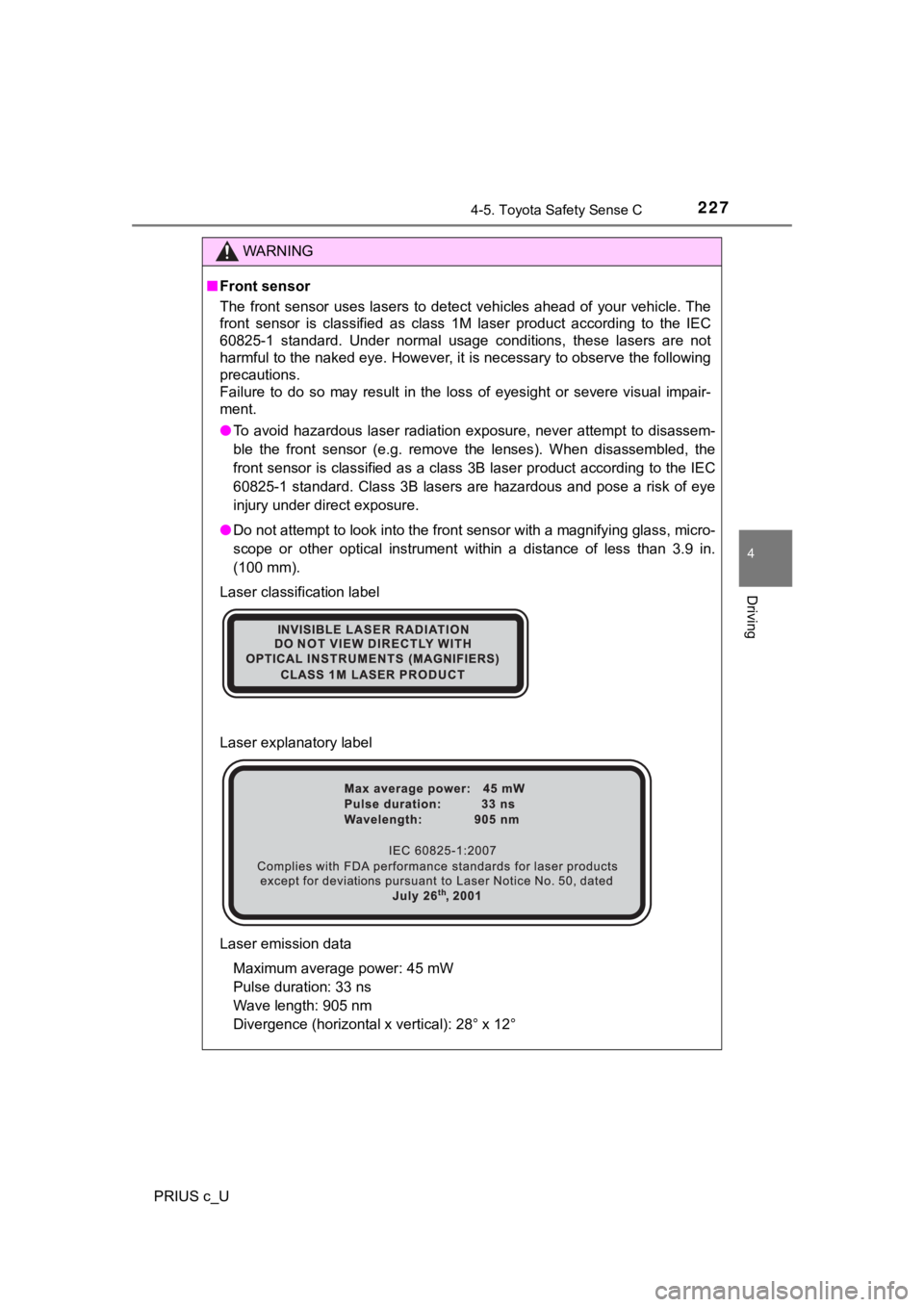
2274-5. Toyota Safety Sense C
4
Driving
PRIUS c_U
WARNING
■Front sensor
The front sensor uses lasers to detect vehicles ahead of your vehicle. The
front sensor is classified as class 1M laser product according to the IEC
60825-1 standard. Under normal usage conditions, these lasers a re not
harmful to the naked eye. However, it is necessary to observe the following
precautions.
Failure to do so may result in the loss of eyesight or severe v isual impair-
ment.
● To avoid hazardous laser radiation exposure, never attempt to d isassem-
ble the front sensor (e.g. remove the lenses). When disassemble d, the
front sensor is classified as a class 3B laser product accordin g to the IEC
60825-1 standard. Class 3B lasers are hazardous and pose a risk of eye
injury under direct exposure.
● Do not attempt to look into the front sensor with a magnifying glass, micro-
scope or other optical instrument within a distance of less tha n 3.9 in.
(100 mm).
Laser classification label
Laser explanatory label
Laser emission data Maximum average power: 45 mW
Pulse duration: 33 ns
Wave length: 905 nm
Divergence (horizontal x vertical): 28° x 12°
Page 228 of 600
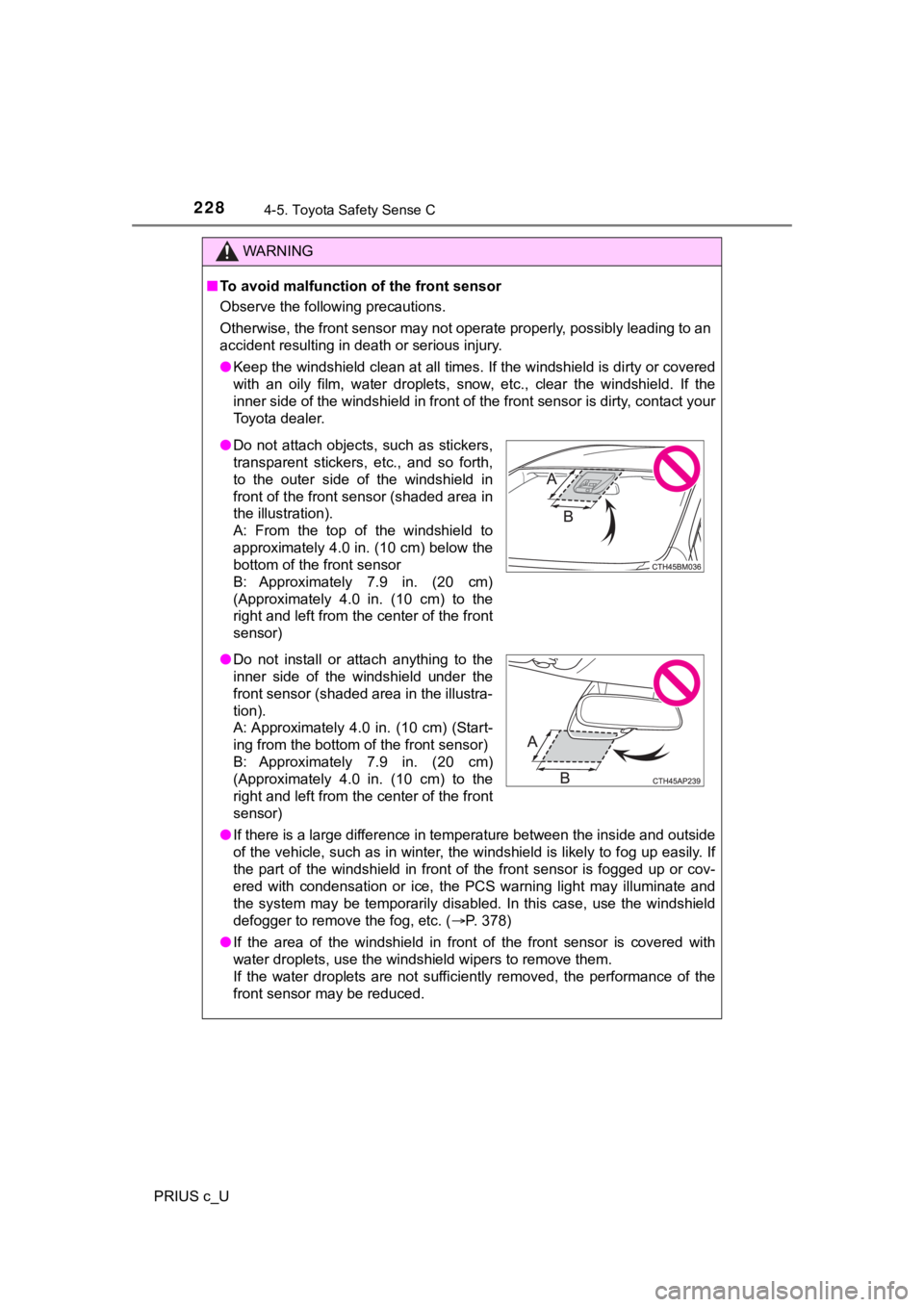
2284-5. Toyota Safety Sense C
PRIUS c_U
WARNING
■To avoid malfunction of the front sensor
Observe the following precautions.
Otherwise, the front sensor may not operate properly, possibly leading to an
accident resulting in death or serious injury.
● Keep the windshield clean at all times. If the windshield is di rty or covered
with an oily film, water droplets, snow, etc., clear the windshield. If the
inner side of the windshield in front of the front sensor is dirty, contact your
Toyota dealer.
● If there is a large difference in temperature between the inside and outside
of the vehicle, such as in winter, the windshield is likely to fog up easily. If
the part of the windshield in front of the front sensor is fogg ed up or cov-
ered with condensation or ice, the PCS warning light may illumi nate and
the system may be temporarily disabled. In this case, use the w indshield
defogger to remove the fog, etc. ( P. 378)
● If the area of the windshield in front of the front sensor is covered with
water droplets, use the windshield wipers to remove them.
If the water droplets are not sufficiently removed, the performance of the
front sensor may be reduced.
●Do not attach objects, such as stickers,
transparent stickers, etc., and so forth,
to the outer side of the windshield in
front of the front sensor (shaded area in
the illustration).
A: From the top of the windshield to
approximately 4.0 in. (10 cm) below the
bottom of the front sensor
B: Approximately 7.9 in. (20 cm)
(Approximately 4.0 in. (10 cm) to the
right and left from the center of the front
sensor)
● Do not install or attach anything to the
inner side of the windshield under the
front sensor (shaded area in the illustra-
tion).
A: Approximately 4.0 in. (10 cm) (Start-
ing from the bottom of the front sensor)
B: Approximately 7.9 in. (20 cm)
(Approximately 4.0 in. (10 cm) to the
right and left from the center of the front
sensor)
Page 229 of 600
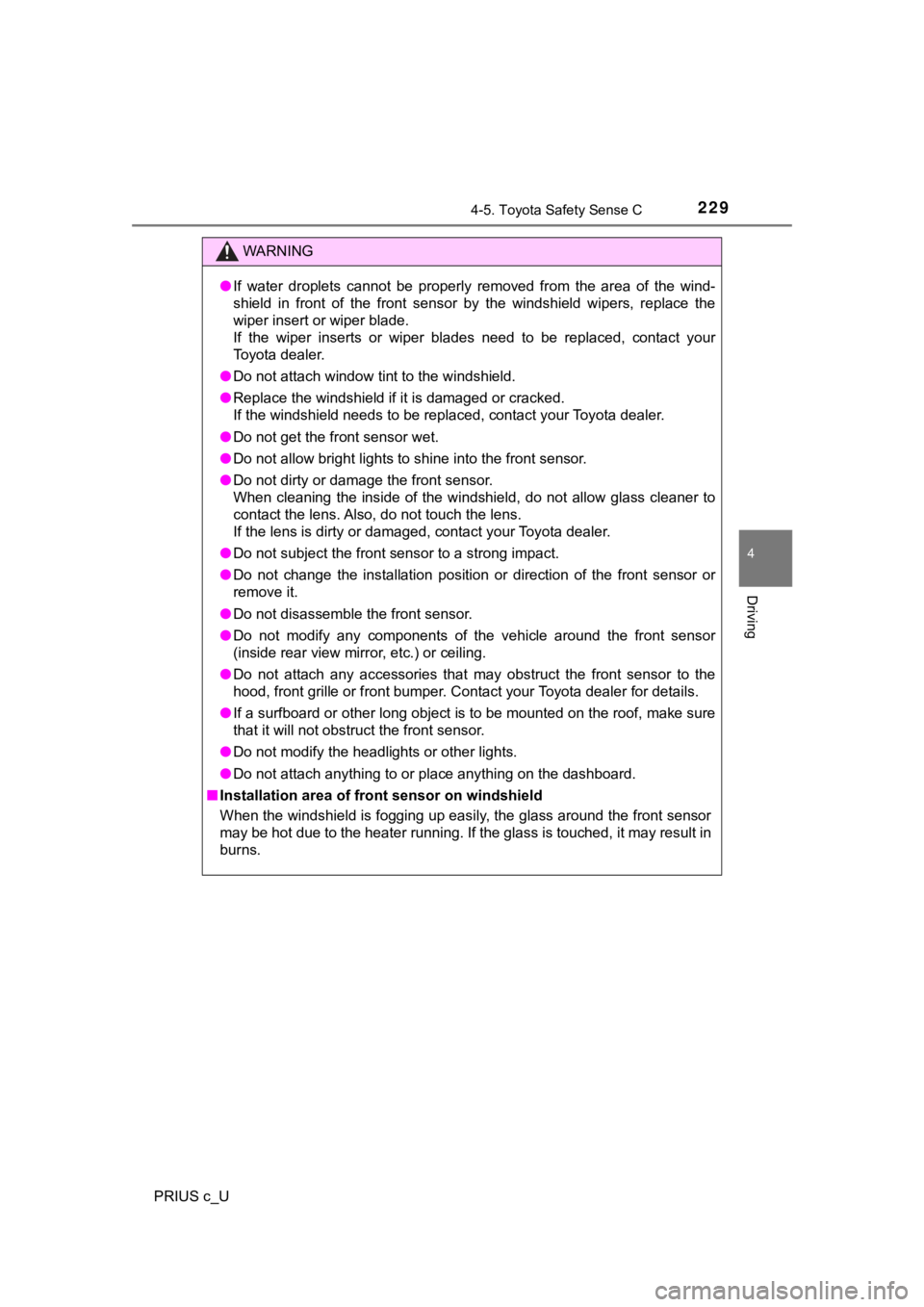
2294-5. Toyota Safety Sense C
4
Driving
PRIUS c_U
WARNING
●If water droplets cannot be properly removed from the area of t he wind-
shield in front of the front sensor by the windshield wipers, r eplace the
wiper insert or wiper blade.
If the wiper inserts or wiper blades need to be replaced, contact your
Toyota dealer.
● Do not attach window tint to the windshield.
● Replace the windshield if it is damaged or cracked.
If the windshield needs to be replaced, contact your Toyota dea ler.
● Do not get the front sensor wet.
● Do not allow bright lights to shine into the front sensor.
● Do not dirty or damage the front sensor.
When cleaning the inside of the windshield, do not allow glass cleaner to
contact the lens. Also, do not touch the lens.
If the lens is dirty or damaged, contact your Toyota dealer.
● Do not subject the front sensor to a strong impact.
● Do not change the installation position or direction of the fro nt sensor or
remove it.
● Do not disassemble the front sensor.
● Do not modify any components of the vehicle around the front sensor
(inside rear view mirror, etc.) or ceiling.
● Do not attach any accessories that may obstruct the front senso r to the
hood, front grille or front bumper. Contact your Toyota dealer for details.
● If a surfboard or other long object is to be mounted on the roo f, make sure
that it will not obstruct the front sensor.
● Do not modify the headlights or other lights.
● Do not attach anything to or place anything on the dashboard.
■ Installation area of front sensor on windshield
When the windshield is fogging up easily, the glass around the front sensor
may be hot due to the heater running. If the glass is touched, it may result in
burns.
Page 230 of 600
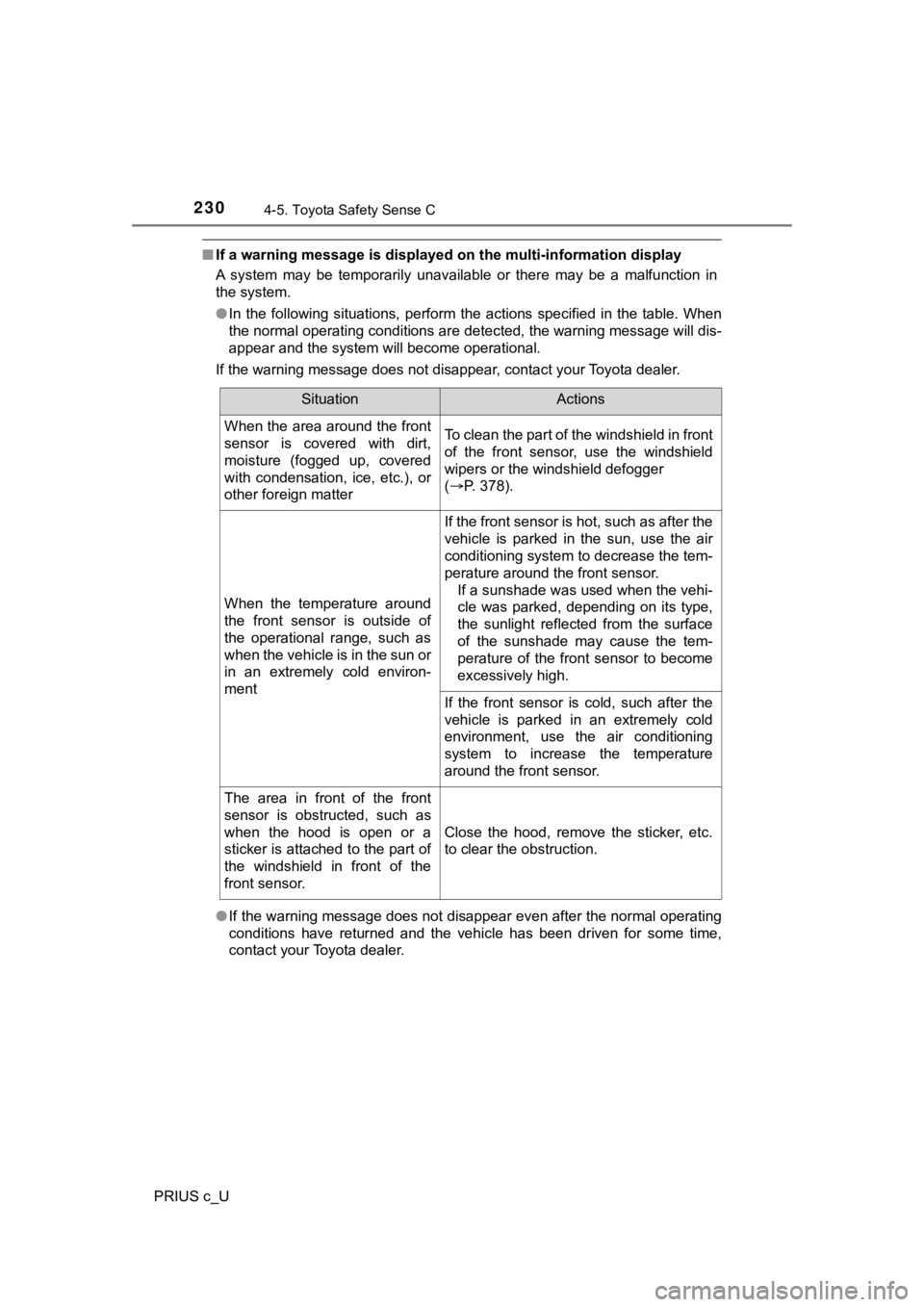
2304-5. Toyota Safety Sense C
PRIUS c_U
■If a warning message is displayed on the multi-information disp lay
A system may be temporarily unavailable or there may be a malfu nction in
the system.
● In the following situations, perform the actions specified in t he table. When
the normal operating conditions are detected, the warning messa ge will dis-
appear and the system will become operational.
If the warning message does not disappear, contact your Toyota dealer.
● If the warning message does not disappear even after the normal operating
conditions have returned and the vehicle has been driven for so me time,
contact your Toyota dealer.
SituationActions
When the area around the front
sensor is covered with dirt,
moisture (fogged up, covered
with condensation, ice, etc.), or
other foreign matterTo clean the part of the windshield in front
of the front sensor, use the windshield
wipers or the windshield defogger
( P. 378).
When the temperature around
the front sensor is outside of
the operational range, such as
when the vehicle is in the sun or
in an extremely cold environ-
ment
If the front sensor is hot, such as after the
vehicle is parked in the sun, use the air
conditioning system to decrease the tem-
perature around the front sensor.
If a sunshade was used when the vehi-
cle was parked, depending on its type,
the sunlight reflected from the surface
of the sunshade may cause the tem-
perature of the front sensor to become
excessively high.
If the front sensor is cold, such after the
vehicle is parked in an extremely cold
environment, use the air conditioning
system to increase the temperature
around the front sensor.
The area in front of the front
sensor is obstructed, such as
when the hood is open or a
sticker is attached to the part of
the windshield in front of the
front sensor.
Close the hood, remove the sticker, etc.
to clear the obstruction.